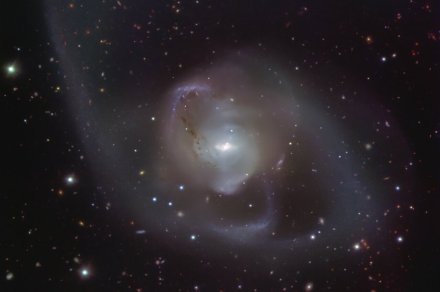
At the heart of almost every galaxy lies an enormous black hole. These monsters are so massive that they get a classification of their own: supermassive black holes, with masses millions or even billions of times the mass of our sun. And when two galaxies collide, their supermassive black holes get closer and closer until these beasts eventually merge as well.
This almost incomprehensible process is on display in an image recently shared by the European Southern Observatory (ESO), showing an almost-merged galaxy that contains the closest pair of supermassive black holes ever discovered at just 1,600 light years apart. Galaxy NGC 7727 started off as two galaxies, which began merging around a billion years ago, and within the next few hundred million years, the two supermassive black holes are set to collide, creating an even bigger black hole in the process.
The image was taken using the Very Large Telescope, a ground-based telescope located in the Atacama Desert in Chile that is made up of four individual telescopes, each of which has a primary mirror 8.2 meters across. On one of these telescopes, named VLT UT1, is an instrument called the FOcal Reducer and low dispersion Spectrograph 2 or FORS2, which is capable of taking spectrometry data from multiple targets at the same time as well as measuring the polarization of light.
FORS2 captured the galaxy in which the two black holes are approaching each other in this image, showing how areas of stars, dust, and gas around the edges of the galaxy are stretched out into space, creating tails that reach out from the galaxy’s main body.
This image also provides a creepy preview of what could eventually happen to our home galaxy, the Milky Way, when it merges with the nearby Andromeda Galaxy in billions of years. As ESO writes, “Our home galaxy, which also sports a supermassive black hole at its center, is on a path to merge with our closest large neighbor, the Andromeda Galaxy, billions of years from now. Perhaps the resulting galaxy will look something similar to the cosmic dance we see in NGC 7727, so this image could be giving us a glimpse into the future.”
Editors’ Recommendations
-
Orion spacecraft’s upcoming moon voyage depicted in new animation
-
Astronaut snaps ‘spectacular’ aurora from the space station
-
This colorful Hubble dreamscape is sculpted by newborn stars
-
Six tiny satellites will form a huge virtual telescope to study space weather
-
Betelgeuse blew its top, leaving an interior jiggling like jelly

0 Comments :
Post a Comment